Spandrel Panels
Extending on part of the theme of our last Top Tip – the separating element acting as a ‘barrier’ to the passage of sound – it is worth remembering the importance of continuing the ‘barrier’ through roof voids. We are asked occasionally whether it is really necessary to continue the separating wall construction up through a roof void. The answer, for the Robust Details specifications, is ‘yes’. This is due to the potential for sound transmission via the flanking route up through the ceiling, via the roof void and over into the adjacent dwelling.
It is therefore appropriate and necessary to complete the separating wall element right through the roof void, finishing with a flexible (mineral wool based) closer up to the underside of the roof covering. This is consistent over the various contexts in which Robust Details can be used, as the examples below.
Roof junctions with potential sound transmission path indicated by arrows:
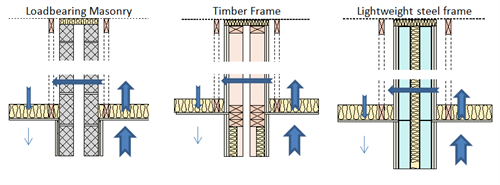
An alternative option for loadbearing masonry construction, where there is no room-in-roof[1], is the use of a spandrel panel. The details for this are provided in Appendix A1 of the Robust Details Handbook, as indicated below
[1] There are proprietary room in the roof solutions detailed in Appendix 2 of the Robust Details Handbook
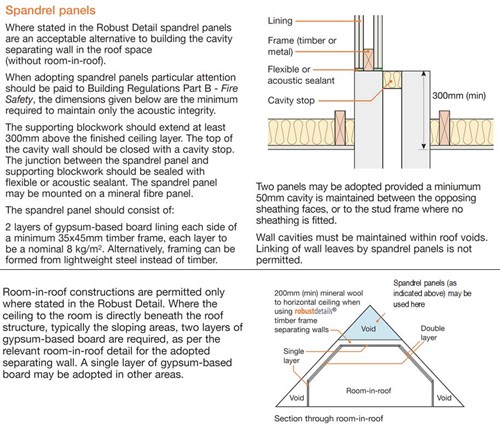
The following should also be noted.
- The specification for the spandrel panel, in terms of the required sound insulation performance, does not specifically require insulation within the spandrel panel. Although, insulation may be provided if required/considered appropriate – possibly in relation to other standards.
- All cavities must be maintained within roof voids. Linking of wall leaves by spandrel panels is not permitted. If necessary and as noted, for more complex wall layouts with intersections of separating walls, two panels may be adopted provided they are constructed with a minimum 50mm cavity maintained between wall panels, or stud should board be omitted from the inner (cavity side) faces of the spandrel panels.
- In relation to spandrel panels used in the roof voids above room-in-roof situations, the cavity blockwork separating wall construction must extend for 300mm (min) above the flat ceiling line of the room-in-roof area – into the roof void above.
- In all cases other Building Regulations and standards, which are outside the remit of Robust Details Limited, should also be considered.
The second of the bullet points above is very important and, seemingly, sometimes is something that is overlooked. The performance monitoring site visits undertaken by Robust Details Limited have identified cases where incorrect detailing, in relation to the use of spandrel panels, has led to sound insulation performance issues. In one case in particular the inspector undertook a test on a separating wall at top floor level. The difference between the results from the test at the top floor with that at the lower floor was 11dB. Through investigations it was revealed that the sound transmission was via the roof void. This led to an inspection within the roof void, which revealed that a spandrel panel detail had been implemented but that the top of the cavity masonry wall had been closed with a block laid flat – causing a bridge between the wall leaves. This is as shown in the sketch below. Shortly afterwards another inspector came across a similar detail, as shown in the photograph, which was under-construction on another site.
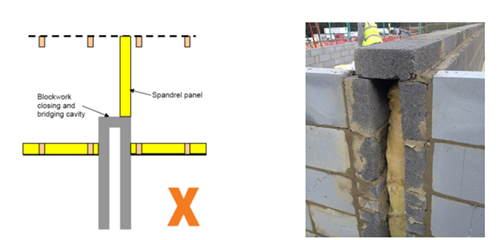
Cavity masonry separating wall incorrectly closed off with a block laid flat below spandrel panel.
Further relevant images…
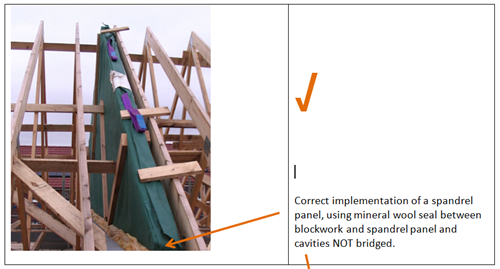
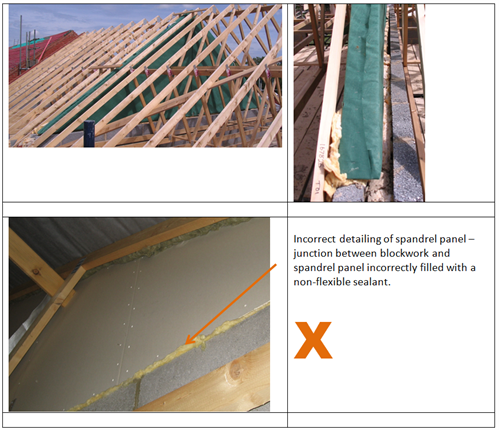
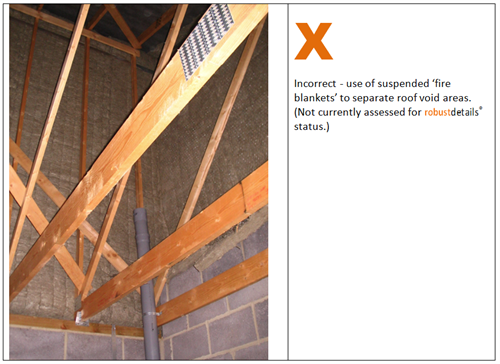
If you have any techncial enquiries please do not hesitate to contact our technical team on 03300 882140 or email: technical@robustdetails.com
Return to the Top Tips page

